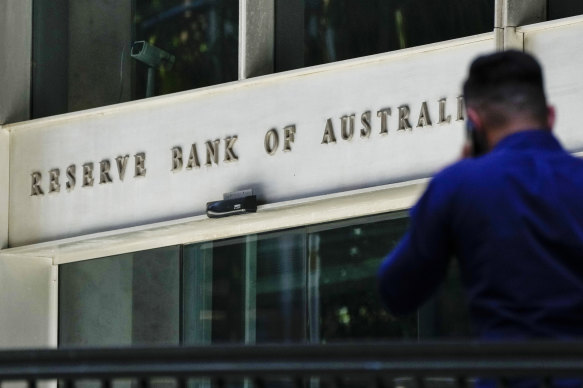Stash cash now: Why this may be the sweet spot for savers
People, our interest rates reckoning is upon us, and we know the stakes are high. As I write this, the big four banks – who are gazing into their crystal balls for what the Reserve Bank will decide on Tuesday – are divided. Two expect another rate rise; two expect a hold.
This would be the first hold in 11 months, not forgetting that four of the hikes were double, 50-basis-point ones. Borrowers around the country will be holding their breath. Most of them dearly need a break.
Savers have been the winners in the past year, but it won’t last forever. Best to look at a long-term goal now.Credit:Dionne Gain
So will retirees and people with money in the bank. Slowly, silently and maybe a bit smugly, savers have been the winners in the past year. But this may be the lock-in-or-lose-out term-deposit sweet spot.
Let me be clear, most economists believe there are more rate hikes to come. But a terminal, top official interest rate of 3.85 per cent is now a popular prediction, meaning one more rise.
Some are even forecasting rate falls as soon as November.
No, we haven’t won the inflation war, but last week the monthly reading came in at just 6.8 per cent, after 7.4 per cent in January and 8.4 per cent in December, so we may be getting the upper hand.
The thing about those big-bank soothsayers is that they predict our home-loan pricing too, or have a significant hand in it. That’s really the whole point.
Lowered interest rate expectations mean both a lowering in longer-term fixed-rate mortgage offers and term-deposit rates.
This means mortgage holders who want to fix (I only ever believe in fixing half your loan) should wait and watch this space. But anyone with a cash stash may have no time to lose.
There is also another factor feeding into the equation for the moment: since the collapse of several US banks, some Australian banks are seeking more domestic funding. If they can get this from local depositors, it could be cheaper than from overseas.
With the interest outlook now so finely balanced, I asked financial comparison company Mozo to perform an exclusive analysis of the available at-call (eg. freely accessible bank accounts) savings rates versus term deposit alternatives. And their movements.
Guess what? Almost all those deposit takers also offer mortgages … so many are boosting rates further to harness this cheaper way of funding them.
The other point of note is that many at-call savings rates remain better than the top term-deposit rates.
But once rates start to fall, that edge will evaporate. It’s a punt, but maybe there are only six months left of at-call accounts having the advantage. Term deposit rates, meanwhile, always tick back before the official rate moves downwards.
Indeed, they could become unattractive overnight. Particularly those that are longer dated than one year. Some banks have already begun slicing off interest from their offerings. And that’s where the urgency comes in.
Some economists are predicting the RBA could start to lower rates by the end of the year.Credit:AP
But let’s put some numbers on all this. Mozo says the best at-call interest rate is 4.25 per cent, offered by ANZ plus. Or I should say, that is the best without-conditions rate.
More common nowadays are incentive-saver-style accounts where you jump through monthly hoops to get bigger rate rewards. These will have a base or ongoing rate and then a (usually much larger) bonus rate.
The bonus rate might be contingent upon, say, five deposits a month, no withdrawals, and your balance increasing, or something similar.
If you are saving for something in a dedicated way, like a house deposit, you might meet the conditions every month. So a high bonus rate would suit.
But if you are also using this account for a bit of living, and might miss the mark on some months, the best approach is to compare an account with a generous base rate with the all-the-time ANZ rate I mentioned above.
For savers aged 14 to 35, the maximum interest from an incentive saver account is Bank of Queensland’s Future Saver account, paying up to 5.15 per cent.
But for everybody else, ING’s Savings Maximiser is the highest-paying pick. You need a linked Orange Everyday account, but it pays as much as 5 per cent.
The accounts with Virgin Money (up to 4.85 per cent), MOVE Bank (4.75 per cent) and Great Southern Bank (4.75 per cent) are also potentially decent. You’ll optimise your rate by matching the interest-trigger conditions of any given account with your operational needs.
Every interest rate number I’ve mentioned so far is variable. They will all fall in lockstep with the RBA’s rate lopping.
What, then, of term deposits? Over one year, you can get 4.65 per cent as a top rate with Alex Bank, according to Mozo. Over two years, Judo Bank takes the cake with 4.85 per cent.
It also trounces the other term deposits over three and four years, with 4.9 per cent, and five years, with 5 per cent. All of those come close to the best at-call account in the country.
And remember, there might be months you forfeit the interest rate, which would bring down your annual interest.
The only other factor to consider though is the “at-call” part. Break a term deposit, and you kiss goodbye to a large chunk of the interest.
Once again, you need to match your choice to your expected usage. But for term-deposit rates, mull and match them fast.
Because the interest environment is very much live, and those rates could soon be much lower.
- Advice given in this article is general in nature and is not intended to influence readers’ decisions about investing or financial products. They should always seek their own professional advice that takes into account their own personal circumstances before making any financial decisions.
Nicole Pedersen-McKinnon is the author of How to Get Mortgage-Free Like Me. Follow Nicole on Facebook, Twitter or Instagram.
The Money with Jess newsletter helps you budget, earn, invest and enjoy your money. Sign up to get it every Sunday.
Most Viewed in Money
From our partners
Source: Read Full Article



